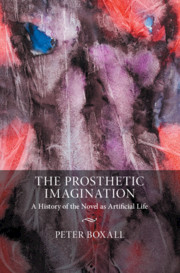Book contents
- The Prosthetic Imagination
- The Prosthetic Imagination
- Copyright page
- Dedication
- Epigraph
- Contents
- Illustrations
- Acknowledgements
- Introduction
- Part I The Body and the Early Modern State: From More to Cavendish
- Part II The Colonial Body: From Behn to Goethe
- Part III The Manufactured Body: From Wollstonecraft to Stoker
- Chapter 4 The Dead Hand: Realism and Biomaterial in the Nineteenth-Century Novel
- Chapter 5 Strange Affinity: Gothic Prosthetics from Shelley to Stoker
- Part IV The Modernist Body: From James to Beckett
- Part V The Posthuman Body: From Orwell to Atwood
- Notes
- Bibliography
- Index
Chapter 5 - Strange Affinity: Gothic Prosthetics from Shelley to Stoker
from Part III - The Manufactured Body: From Wollstonecraft to Stoker
Published online by Cambridge University Press: 18 September 2020
- The Prosthetic Imagination
- The Prosthetic Imagination
- Copyright page
- Dedication
- Epigraph
- Contents
- Illustrations
- Acknowledgements
- Introduction
- Part I The Body and the Early Modern State: From More to Cavendish
- Part II The Colonial Body: From Behn to Goethe
- Part III The Manufactured Body: From Wollstonecraft to Stoker
- Chapter 4 The Dead Hand: Realism and Biomaterial in the Nineteenth-Century Novel
- Chapter 5 Strange Affinity: Gothic Prosthetics from Shelley to Stoker
- Part IV The Modernist Body: From James to Beckett
- Part V The Posthuman Body: From Orwell to Atwood
- Notes
- Bibliography
- Index
Summary
This chapter, the second of two chapters focusing on the nineteenth-century prosthetic imagination, suggests that the Gothic tradition offers another way of thinking about the dead hand. It reads dead-handedness, or mortmain, as it runs through the Gothic novel of the period, from Shelley to Poe to Stoker, Stevenson and Wilde, to suggest that the Gothic offers an undertow to the work of the realist novel in transforming dead flesh into living being. The Gothic works against the realist novel, in is refusal of the animating work of narrative; but as the chapter reads this opposition, it suggests a shared investment, in both the realist and the Gothic traditions, in the tension between dead and living material, under the conditions produced by industrialisation, and by emerging information technologies.
Keywords
- Type
- Chapter
- Information
- The Prosthetic ImaginationA History of the Novel as Artificial Life, pp. 201 - 222Publisher: Cambridge University PressPrint publication year: 2020

